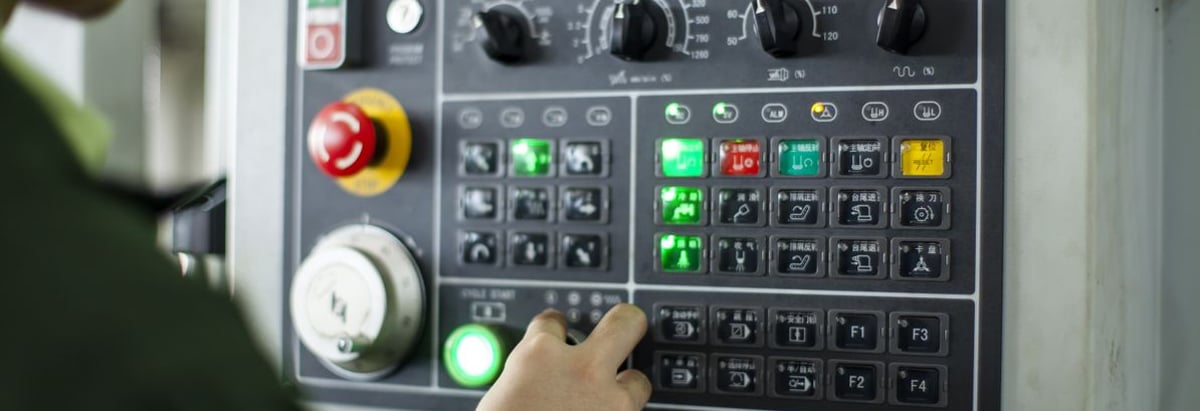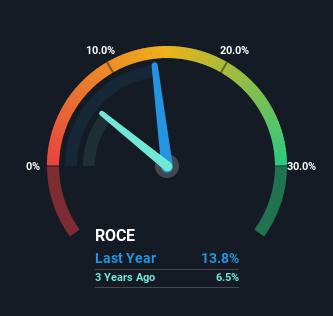Hanza (STO:HANZA) Shareholders Will Want The ROCE Trajectory To Continue

To find a multi-bagger stock, what are the underlying trends we should look for in a business? Ideally, a business will show two trends; firstly a growing return on capital employed (ROCE) and secondly, an increasing amount of capital employed. This shows us that it's a compounding machine, able to continually reinvest its earnings back into the business and generate higher returns. So on that note, Hanza (STO:HANZA) looks quite promising in regards to its trends of return on capital.
Return On Capital Employed (ROCE): What Is It?
For those that aren't sure what ROCE is, it measures the amount of pre-tax profits a company can generate from the capital employed in its business. The formula for this calculation on Hanza is:
Return on Capital Employed = Earnings Before Interest and Tax (EBIT) ÷ (Total Assets - Current Liabilities)
0.14 = kr158m ÷ (kr2.2b - kr1.1b) (Based on the trailing twelve months to June 2022).
Thus, Hanza has an ROCE of 14%. On its own, that's a standard return, however it's much better than the 9.7% generated by the Electronic industry.
Check out our latest analysis for Hanza

In the above chart we have measured Hanza's prior ROCE against its prior performance, but the future is arguably more important. If you'd like, you can check out the forecasts from the analysts covering Hanza here for free.
So How Is Hanza's ROCE Trending?
Investors would be pleased with what's happening at Hanza. Over the last five years, returns on capital employed have risen substantially to 14%. The company is effectively making more money per dollar of capital used, and it's worth noting that the amount of capital has increased too, by 187%. So we're very much inspired by what we're seeing at Hanza thanks to its ability to profitably reinvest capital.
On a separate but related note, it's important to know that Hanza has a current liabilities to total assets ratio of 48%, which we'd consider pretty high. This effectively means that suppliers (or short-term creditors) are funding a large portion of the business, so just be aware that this can introduce some elements of risk. Ideally we'd like to see this reduce as that would mean fewer obligations bearing risks.
The Bottom Line On Hanza's ROCE
To sum it up, Hanza has proven it can reinvest in the business and generate higher returns on that capital employed, which is terrific. Since the stock has returned a staggering 358% to shareholders over the last five years, it looks like investors are recognizing these changes. So given the stock has proven it has promising trends, it's worth researching the company further to see if these trends are likely to persist.
If you'd like to know about the risks facing Hanza, we've discovered 1 warning sign that you should be aware of.
While Hanza may not currently earn the highest returns, we've compiled a list of companies that currently earn more than 25% return on equity. Check out this free list here.
Valuation is complex, but we're here to simplify it.
Discover if Hanza might be undervalued or overvalued with our detailed analysis, featuring fair value estimates, potential risks, dividends, insider trades, and its financial condition.
Access Free AnalysisHave feedback on this article? Concerned about the content? Get in touch with us directly. Alternatively, email editorial-team (at) simplywallst.com.
This article by Simply Wall St is general in nature. We provide commentary based on historical data and analyst forecasts only using an unbiased methodology and our articles are not intended to be financial advice. It does not constitute a recommendation to buy or sell any stock, and does not take account of your objectives, or your financial situation. We aim to bring you long-term focused analysis driven by fundamental data. Note that our analysis may not factor in the latest price-sensitive company announcements or qualitative material. Simply Wall St has no position in any stocks mentioned.
About OM:HANZA
Reasonable growth potential with mediocre balance sheet.
Similar Companies
Market Insights
Community Narratives



